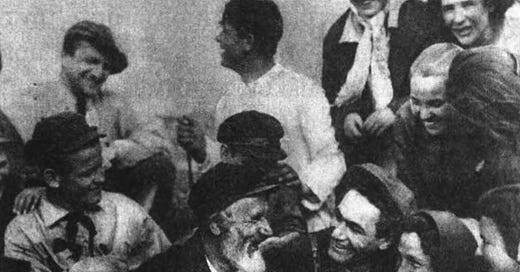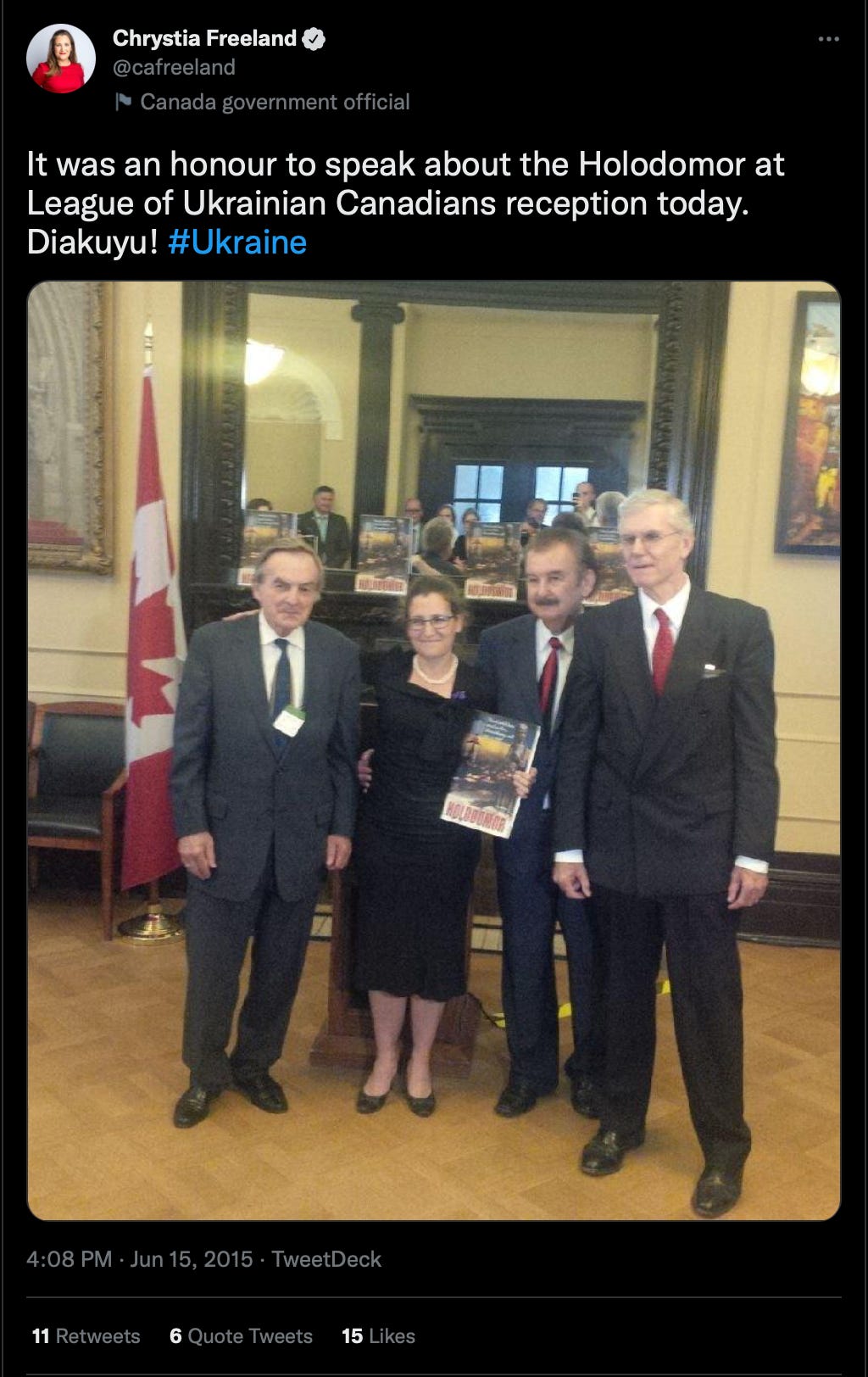This is an installment of The Soviet Jew: A Weaponized Immigrant’s Tale. Read the previous bit here.
In my last big installment, I wrote about my grandmother’s Ukrainian shtetl and my family’s lost history of pogroms. In this installment, I want to write about another big mystery that hangs over that branch of my family: Why did my grandmother Rosa and the rest of her relatives suddenly flee the shtetl and head south to Crimea.
This was in 1933, a decade after she and her parents had already survived multiple waves of pogroms. If the pogroms weren’t enough to send them packing, what happened in those first few years of the 1930s? And they didn’t just leave and go to some nearby big industrializing city, like was normal at the time. They left for Crimea. The question is: Why? The answer: No one in the family knows. This part of our history is completely missing from the oral record.
For a while now I’ve wanted to try to reconstruct what happened. But I wasn’t sure where to start. We simply don’t have any family stories or documents that could have provided even a hint at what happened. No one from that generation — not my grandmother, not my great-grandmother — talked about it with my mother. It’s as if there’s a cloud of silence that hung over that episode — as if there was something about it that no one wanted to discuss. Now I think I know why.
Since I had no personal family information, I delved into the problem the only way I knew how: by looking at the local context. What was happening in their region at the time? What were the bigger events taking place in Soviet Ukraine?
Now I think I know why the fled the shtetl: It was the horrible famine that was raging in Soviet Ukraine at the time.
I admit the proof I have is meager and circumstantial. Things align. But I could be wrong. But that doesn’t even matter that much. Because as I pieced this history together, I stumbled onto something much bigger than just my family story — something that’s surprisingly relevant to the Ukrainian politics and mythologizing that’s happening today. It has to do with the Holodomor. And in particular: the erasure of Jewish victims from the Ukrainian famine genocide narrative.
My family on my grandmother’s side is from Central Ukraine — from a few shtetls about 120 miles south of Kiev. While trying to learn the history of the particular shtetl where I think my grandmother was born, I found a Ukrainian encyclopedia entry that mentioned the village was hit by famine in 1932-1933. As it explained: “A memorial sign was erected to the victims of the Holodomor in the village cemetery in 1991.” I asked my mom if she knew anything about it and she shook her head. No, she had no idea. No one in the family told her about any famine from where they were from.
It might seem strange that no one said anything about it. Even if my family had enough to eat back then, they must have at least seen people starving. It would have been hard not to notice. The famine killed at least several million people. Starving people from the countryside swarmed the big cities, where people were also starving. The army was even brought out to prevent the flood of miserable people that was clogging the big centers.
But then, my family’s silence is not so surprising. As I wrote before, it may be hard for us to understand in this age of oversharing and our constant focus on trauma and micro-aggressions and PTSD, but that old generation generally kept quiet about the horrible things they had to endure. What was the point of picking at the scabs and reliving the horrors of the past? How could it possibly help? It just wasn’t done. And about the famine, people had an additional incentive to keep quiet: politically it was taboo. The topic was censored.
“Jews on the land,” Ogonek magazine, 1930. (Source: Felix Kandel’s A Book of Times and Events.)
My grandmother’s family didn’t farm. Like most Jews, they were small time merchants, lumpen capitalists that dealt in bread and grain out of their stalls. They had no power. So if grain was suddenly in short supply, like it was in in 1932 and 1933, they would have suffered along with the Ukrainian peasant farmers who produced the stuff. But there were Jewish farmers — not many, but they existed. And they suffered right there along with the Ukrainian peasants.
In his history of Soviet Jews, Felix Kandel — who was one of the writers behind the cult cartoon Soviet Nu, pogodi! back in the Soviet days — lays out some of what was going on:
During the “Holodomor” of 1932-1933, the biggest victims were in Ukrainian villages. The famine did not bypass their neighbors, Jewish farmers. Many Jewish collective farms were included in the list of the Council of People's Commissars of Ukraine as the most affected by the famine. Among the areas with the highest mortality was the Kalinindorf Jewish National Region. Outside the collective farms, in the cities and towns of Ukraine, there lived a huge number of Jewish artisans who worked for the rural population — tailors, shoemakers, tinsmiths, carpenters and blacksmiths; With the onset of famine, the orders of the surrounding farmers ceased, and the traditional delivery of products to the small-town bazaars also ceased. Now everyone was starving, and official documents of that time confirmed this.
Who was to blame for the famine?
It’s all politicized and muddy now.
But as I understand it, all the credible history points to a hybrid reason: several years of bad weather and bad harvests were made much worse by the Soviet Union’s forced collectivization and industrialization campaigns. As a result there was simply not enough grain available and actual crop yields were much lower than official predictions — and yet Soviet officials, frequently ignorant of the facts and bent on growth and wrenching Soviet agriculture into the glorious industrial age, would not revise their plans and blamed the lack of grain on class enemies and saboteurs and dealt with them severely and harshly.
As historians like Stephen Wheatcroft have argued, declassified archives show that Soviet accelerationism and the harsh methods used to put it into place were in a big way to blame for the hunger and death that spread because of it. But weather played a big role, too. And Ukraine wasn’t the only place where it happened this way. There was even more deadly famine in Kazakhstan at the same time triggered by a very similar mix of causes.
And this wasn’t Ukraine’s only famine during that time. From the World War I through the Russian Civil War and into the 1920s, Ukraine and Russia went through several waves of famines and food shortages, which were made much worse by the epidemics that come riding in on the back of hunger. So the famine of 1930s wasn’t some total anomaly that came out of nowhere. And it wasn’t some sort of devious plot.
But that’s not how the famine is presented to the general public today.
Here in America and in Canada and in Ukraine, the prevailing popular view on it is tightly wound up with Cold War politics, anticommunism, and nationalist narratives coming out of emigre communities. In those circles, the 1932-1933 famine isn’t seen as a horrible but unexpected product of political and environmental factors, it’s presented as a deliberate campaign of genocide — a genocide engineered by Stalin and the Soviet state to wipe out ethnic Ukrainians and to destroy the Ukrainian nation. This view of nationalist history is what’s usually meant when people talk about the Holodomor these days. Some Ukrainian sources claim extraordinary numbers of Ukrainians — 7 million or even 10 million dead, which would make it almost twice as bad as the Holocaust and give Ukrainians genocide supremacy over the Jews.
There’s a big scholarly consensus that very strongly disputes this view. Historians have looked into Soviet archives, but no one’s yet found any evidence that there was ever a plan or a desire by Stalin or his high command to wipe out the Ukrainian people. According to Wheatcroft, Even Robert Conquest — who popularized the genocide theory in his book Bitter Harvest — softened his stance somewhat when new archival research was done after the end of the Soviet Union.
Still, the genocide theory is increasingly seen as the definitive history of what happened. You’ll find statements like “deliberate starvation of the Ukrainian nation” pumped by think-tanks like the Atlantic Council, the policy brain of NATO, Inc. And in Canada, home to a powerful Ukrainian nationalist diaspora, the Holodomor is officially enshrined as a deliberate act of genocide: “deliberately planned and executed by the Soviet regime under Joseph Stalin to systematically destroy the Ukrainian people’s aspirations for a free and independent Ukraine” is how the law that codified a Holodomor day of memory puts it. Naturally Chrystia Freeland — everyone’s favorite deputy prime minister of Canada — constantly talks about it.
Great to see Chrystia Freeland (whose own grandfather collaborated with the Nazis) speak about the Holodomor with the League of Ukrainian Canadians, an emigre group founded by Stepan Bandera’s wing of the Ukrainian nationalist movement — a virulently antisemitic organization that worked with the Nazis and actively genocided Jews and Poles during World War II. The two organizations — the old and the new — even share the same logos. With these kinds of partnerships, you can tell Mrs. Freeland cares about genocide.
What’s gross about a lot of the famine-as-planned-genocide narratives being pumped out by Ukrainian nationalists is how many of them are suffused with antisemitism — the belief that that Jews were at the center of using famine as a way of exterminating ethnic Ukrainians. Various scholars have pointed this out, including John-Paul Himka — who just so happens to be Chrystia Freeland’s uncle.
As John-Paul wrote in 2009, “Blaming the Jews for the Holodomor is part of the entire mentality of zhydokomuna [translation: “kike-communism” —YL], the identification of Jews with communism, that pervades the Ukrainian nationalist discourse and mindset. This is an idea that is considered respectable in the Ukrainian diaspora mainstream media, such as The Ukrainian Weekly.”




